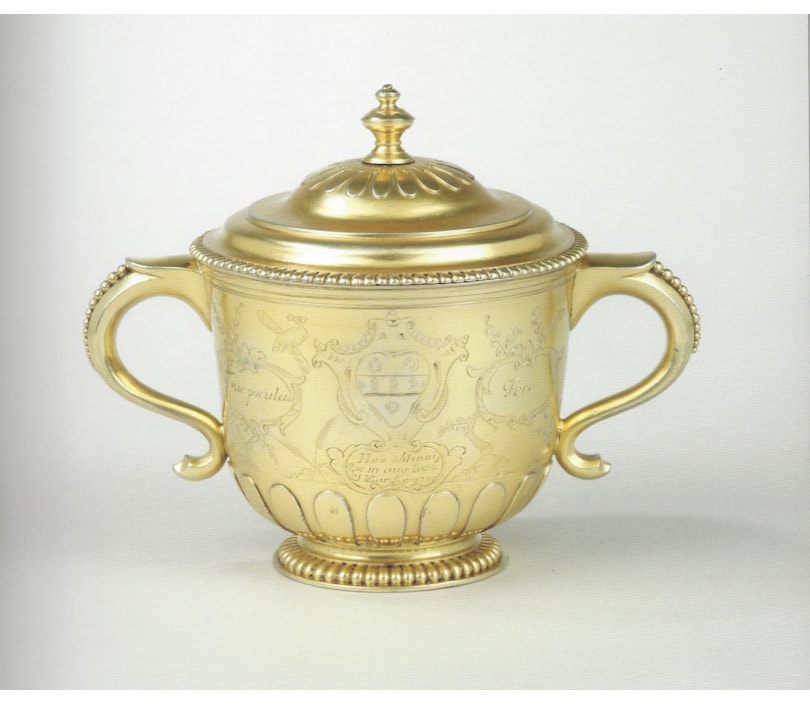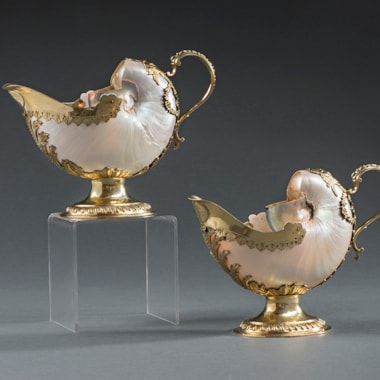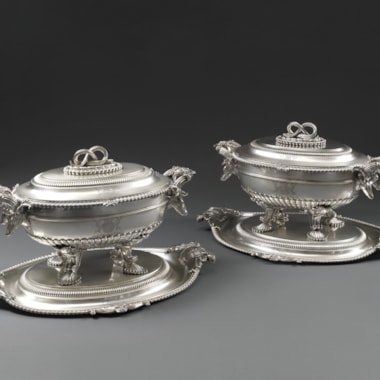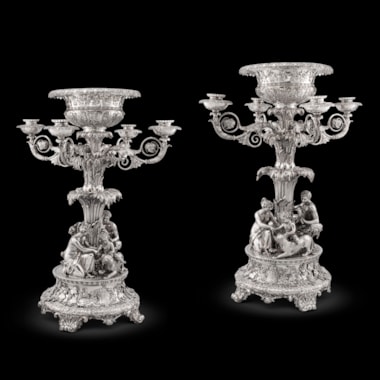The inscription reads:” Hoc obtinui Ex in aug: Iac 2d Et Mar: Ap=23 85” and the motto:” Tria pocula Fero” – “I bear three cups; I obtained this from the coronation of James II and Mary, April 23, 1685”.
The arms are those of Draper for Cresheld or Gawden Draper of Winchelsea. Cresheld Draper was amongst those supporting the King’s canopy and Gawden Draper the Queen’s canopy at the coronation of James II. Cresheld Draper (d. 1693) of Crayford, Kent was M.P. for Winchelsea from 1678 to 1687. He married Sarah Gauden of Clapham, Surrey in 1665.
The Jewel House Delivery Book (Public Record Office, London LC9/43) contains the entry:
April ye 22th Delivered unto S. Benjamin Bathurst Knt. for theire Majties Coronation Twelve Large Canopy staves, crowned with silver 6 for his Majties & 6 for her Majties oz dt
Canopy poiz 369: 10: 0
It 8 gilt Bells 4 each Canopy 061: 15: 0
And received by mee
A further entry of 29th April repeats the order with the comment “all which being claims of the Barrons of ye scinqke ports, for their attendance of the coronation. I say recd by mee for ye use of ye said Barrons”.
At the coronation of a monarch the canopies were traditionally carried by the barons of the Cinque Ports as a symbol of the role that they played in defending the king and the country. Arthur Taylor (see Literature) described the barons’ claim was “... to carry over the king in his procession a canopy of cloth of gold or purple silk, with a gilt silver bell at each corner, supported by four staves covered with silver, four barons to every staff; and to carry a like canopy in the same manner over the queen”. By the time this claim was formalised in a charter of Charles II, the number of barons had increased from four to thirty-two. After the ceremony the barons were entitled to keep the canopies, bells and staves as a perquisite of their position and they were allowed to dine at the table on the king’s right at the coronation banquet. Samuel Pepys described the coronation of Charles II in great detail in his diary entries 22nd and 23rd April 1661 including the King’s entry into Westminster Hall “And the King came in with his crown on, and his sceptre in his hand, under a canopy borne up by six silver staves, carried by Barons of the Cinque Ports, and little bells at every end ... I observed little disorder in all this, but only the King’s footmen had got hold of the canopy, and would keep it from the Barons of the Cinque Ports ...”. It was recorded that at there was scuffling between the barons and “those who would rob them of their treasures” at the coronation of George IV.
In his article in Apollo Edward Perry (see Literature) noted that the staves were usually converted into a piece of plate, as in this case. This practice ceased after the coronation of George IV Examples of the coronation bells of George I, II, III and IV are the collections of the Victoria and Albert Museum and a bell, probably from the coronation of Charles I was in the Albert Collection (Robin Butler, The Albert Collection, 2004, p. 304, no. 374). A George III basket by Edward Aldridge bears the inscription that it was made with silver from a staff carried by John Dilnot at the coronation of George III (sale, Sotheby’s New York, 19th April 1991, lot 315).
The Cinque Ports: Hastings, Romney, Hythe, Dover and Sandwich were granted privileges by the king in exchange for supplying ships and men to protect England’s vulnerable southern coastline. They had to fulfil this obligation at times of war but they also had to make ships available to the king and his retinue when they wished to travel to the continent. This relationship which probably existed earlier was formalised in a Charter of 1260 although the towns were already known as the Cinque Ports by the latter half of the twelfth century. Rye and Winchelsea became part of the group of ports at a later date.
Sale, Sotheby’s New York, 19th April 1990, lot 327
Arthur Taylor, The Glory of Regality: An Historical Treatise of the Anointing and Crowning of the Kings and Queens of England, London, 1820
The Cinque Ports, Blackwood’s Edinburgh Magazine, November 1900, vol. 168, p. 711-718
E. Alfred Jones, Illustrated Catalogue of the Collection of Old Plate of J. Pierpoint Morgan, 1908, p. 33, pl. XXIX
Edward Perry, Gift Plate from Westminster Hall Coronation Banquets, Apollo, June 1953, vol. LVII, no. 340, p. 198-200
You May Also Like








































































